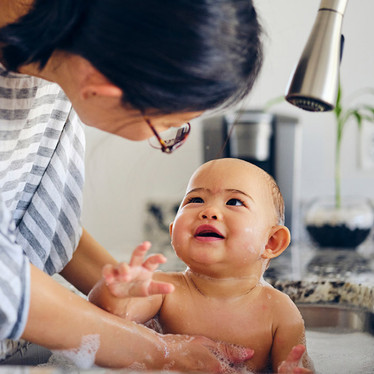
As parents, we can put a lot of pressure on ourselves to know everything, do everything and do it ‘right’. But it’s not always easy. In this guide, we explore the development of baby’s skin during their first year, and practical ways we can care for it and connect with them while doing so. I hope these words land softly with you, please just take what you wish. Here are four areas where caring for your young baby’s skin can make a difference, and how they’ve supported my little girl - Luna’s skin and our connection over the years:
- Why choose natural for baby's sensitive skin
- Caring for baby’s microbiome
- How to make bath time blissful
- The benefits of baby massage
Why choose natural for baby's sensitive skin?
Our skin is a complex and dynamic organ that is involved with several key functions; the main one of course is that it forms a physical barrier between our environment and us. It also regulates our body’s temperature, provides UV protection from the sun, prevents microbial infections, and is the basis of our sensory perception. As soon as a baby is born, the skin barrier development process begins as the skin learns to adapt to this new, comparatively dry environment. This skin barrier development continues throughout and ends around the fourth year of life.
Just to put things in perspective, as this barrier is developing, a baby’s skin is five times thinner than adults. This in turn greatly increases its susceptibility to permeability so anything applied to the skin is more readily absorbed, having a more pronounced effect on the baby’s skin. This layer also works to maintain fluid balance, and an increase in water loss can lead to dryness, sensitivities and irritations.
As a result, baby’s skin can be thought of as sensitive, it needs to be properly cared for. Gentle, hypoallergenic and fragrance-free natural ingredients are important during this developmental time to meet its specific needs. You may have heard of Calendula, or Marigold, a beautiful plant with a bright orange flower. This ingredient is one of the most commonly used plants at Weleda, and the base for our baby range. Calendula envelops baby’s skin in a protective layer, strengthening and supporting the skin’s structure and resilience. It goes beyond other plants with its regenerative and protective capabilities. These elements make it ideal as the main ingredient to nurture and care for baby’s delicate and developing skin.

When thinking about an area that needs extra TLC, the nappy area comes to mind. For all the time a baby is in nappies, Weleda recommends using a nappy change cream that works to prevent irritation and keep the nappy area dry. Creams such as our best-selling Calendula Nappy Change Cream and the White Mallow Nappy Change Cream – especially suitable for highly sensitive skin, containing plant extracts and oils which help to soothe redness and irritation, along with encouraging skin regeneration. Each of these family favourites also contains zinc oxide which can help to protect and enhance the skin barrier by sealing in hydration.
| Shop Calendula Nappy Change Cream → | Shop White Mallow Nappy Change Cream → |
Caring for baby’s microbiome
Millions of microorganisms live on our skin - bacteria, fungi, viruses, and other microbes together comprise what is known as the ‘skin microbiome’ or ‘microflora’. It is this microbiome that protects us from invading pathogens and is crucial in the development and strengthening of our immune system. These microorganisms feed on dead skin cells, our skin’s natural oils, sweat and sebum. They also work to assist the skin’s numerous functions and processes. For example, they contribute to the skin’s acidity levels (measured in pH) and help to maintain its natural barrier activity.
Microbes can affect development as early as in utero, with significant colonisation occurring at birth. Those babies who are born vaginally will be exposed to bacteria from the vagina, and those that are born via C-section will acquire those that are associated with the skin. During the first few weeks of a baby’s life, the microbiome is highly vulnerable and susceptible to numerous outside influences. Preserving and promoting the natural development of the skin microbiome is influential in enhancing health through infancy and into childhood. For example, disruption of this process can contribute to the development of inflammatory conditions such as eczema, nappy rash, and food allergies.
So, what is the link between our skin microbiome and gut flora? Our skin and our intestines have very different ecosystems. Our skin is predominantly influenced by our external environment, by things such as temperature and topical creams. However, the makeup of the human gut microbiome is essentially shaped by what we digest and absorb. Research has shown that these two ecosystems are actually connected through our immune system, as 80% of our immune system is housed in our gut. In babies and children, increased diversity in microorganisms in the gut are associated with better health outcomes, including healthy skin.
Everything a baby breathes, eats and drinks, touches and is bathed in has the potential to affect their microbiome and the creation of immune pathways. Anything that comes into direct contact with the skin such as creams, soaps, moisturisers and detergents can have a key impact on the developing microbiome. Certified natural skincare from Weleda is formulated with gentle and effective ingredients sourced from nature to support baby’s microbiome.
For those who are breastfeeding, research shows it plays a role in establishing a healthy microbiome in babies, as does skin-to-skin contact. Breastmilk contains a rich array of nutrients plus beneficial bacteria and prebiotics. With this in mind, Weleda’s Nursing Tea is a great option to support healthy milk production and nurture the breastfeeding relationship.
|
How to make bath time blissful
The first days, weeks and months with a new baby are an exciting time when everyone is getting to know each other. It is during this time that the feeling of being in safe and loving hands fosters a deep sense of trust between baby and parents. Bath time is a beautiful practice to deepen this. Being in the water is a wonderful opportunity for bonding, and joyfully activates all the senses - especially touch. Daily rituals that include bath time also bring a nurturing rhythm, gifting baby a sense of security and trust.
So how long should you wait for the first bath? A good reference point for the first bath can be when the rest of the umbilical cord falls off. Before that it is enough to just wash baby daily with a damp cloth, ensuring any folds, nappy area, hands and face are clean. After the first week or so, parents may feel more confident in handling their newborn, and the first bath can be enjoyed - hopefully more relaxed. For me Luna just seemed so tiny I felt nervous so I asked my husband to bath her at first!
The element of water can feel unfamiliar to some little ones, especially with the sense of buoyancy and freedom of movement. You will soon find out how your baby reacts to the element of water. It may take more time – that is totally okay. Once bath/cleaning time becomes part of the rhythmic routine, it’s important to keep the folds of the skin clean and the nappy area free of residue. Over time by watching your baby’s cues and getting to know them better, you will figure out when the best time to bathe your baby is; morning, afternoon or evening. We usually bathed Luna in the evening before bed, although there were some mornings that she was really unsettled, and a bath was the perfect relaxer for all.
Babies who enjoy being in the bath can stay in for 3 - 10 minutes. You may already know but it is recommended that the bathroom/room should be warm and cosy - at least 24°C, and the initial temperature of the bath water around 37°C.
Overall, it is important to not overdo the number of products used on your baby’s skin. When bathing its best to use a mild bath product that has been developed for delicate baby skin. For a specially formulated baby product that will gently cleanse and moisturise the skin, Weleda’s Calendula Shampoo and Body Wash is a convenient 2-n-1 containing nourishing ingredients including almond oil, calendula and chamomile, and is suitable for the whole family. For babies with very dry skin, a small amount of Calendula Baby Oil (Fragrance Free) can also be added to the bath water.
| Shop Calendula Shampoo & Body Wash → | Shop Calendula Baby Oil → |
The benefits of baby massage
There are many moments when caring for your baby that also offer important time for communication, attention, and bonding. Baby massage is a wonderful way to support these.
Babies explore the world intensively through direct skin contact and touch. While their eyesight is developing during the first 12 months, touch becomes their first language in life. It plays an essential role in healthy emotional development, stimulates brain development and cognitive abilities. It also helps babies to connect and understand what lies beyond their bodies. They learn where their boundary ends, and the outside world begins – also known as physical self-awareness.
Through the sense of touch, babies perceive temperature and pressure through their skin. Massage brings with it a sense of love, security and trust – for all involved. Through skin-to-skin contact you can gently learn to read and perceive your baby’s signals, which in turn has a positive loving influence on the developing parent-child bond and emotional attachment.
Babies can be massaged from birth onwards - remembering that every baby is unique. Watching how your baby responds to massage is an important way to read their cues. In a calm, quiet, and cosy room, warm some massage oil in the palm of your hands before each movement. There's no need to follow precise instructions while massaging, the most essential element is that baby and caregiver both feel comfortable. Focus on one area at a time, e.g., just the legs and feet, or just the abdomen. Warm, gentle, and intentional touch strengthens bonding and has numerous positive effects on baby. I explored different times to massage Luna, discovering she enjoyed this most in the late afternoon before a bath. This is the beautiful journey parents/caregivers go on in getting to know their little ones even better, and in turn they also signal that their baby’s needs are respected.
As we have discussed, the barrier of baby’s skin is still developing so it’s best to use a gentle product for massaging. Interestingly pure plant oils have a very similar structure to the lipid/fat structures of human skin. They can therefore be easily absorbed into a baby’s natural protective layer. This is the reason a natural plant oil such as Calendula is ideal for baby massage. Weleda’s Calendula Baby Oil (Fragrance Free) helps to gently care for and protect baby’s delicate skin while massaging, allowing the skin to gradually develop its function as a protective layer.
|
Caring for baby’s skin with gentle, natural ingredients and making this time a mindful practice for you to connect and bond is important. What matters most is finding the practices that work best for you and baby and learning along the way. If you’re looking for extra support to find the right product for you and your baby during this time, feel free to reach out to the HealthPost team.
|

